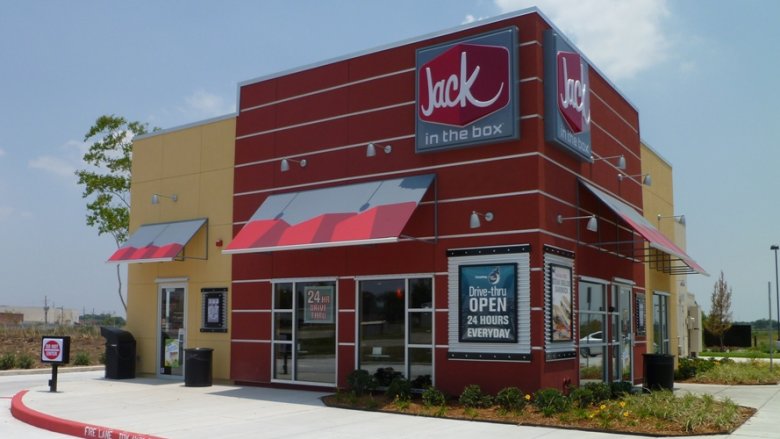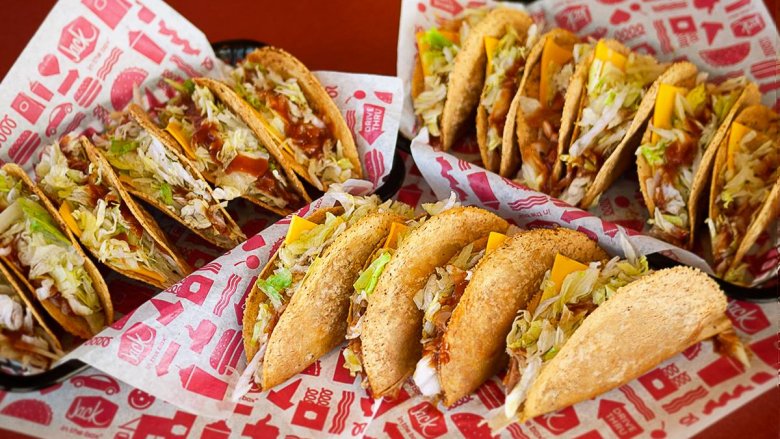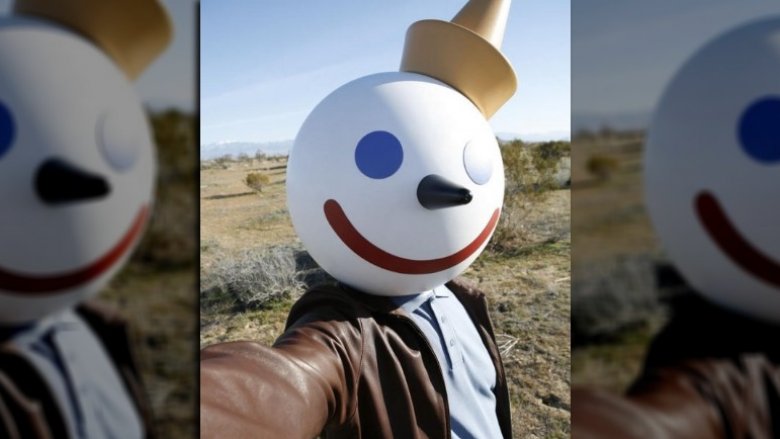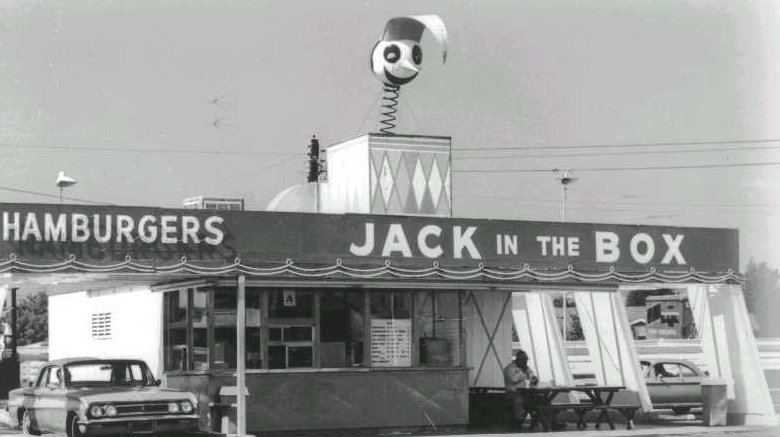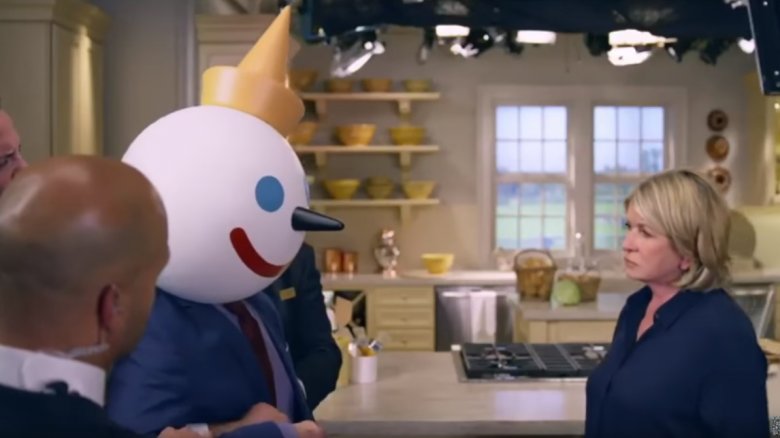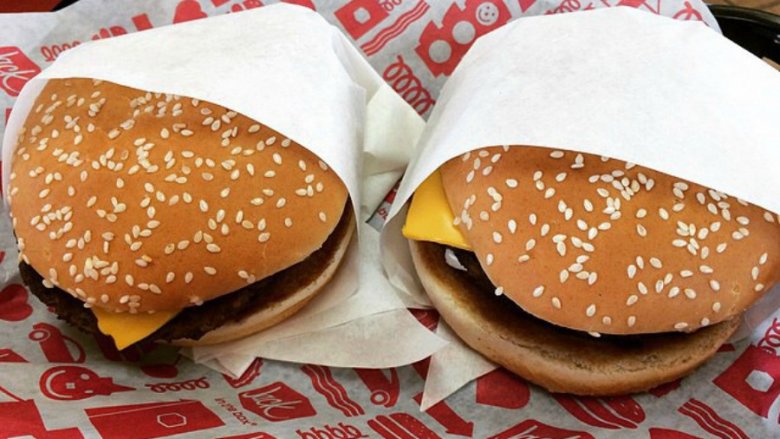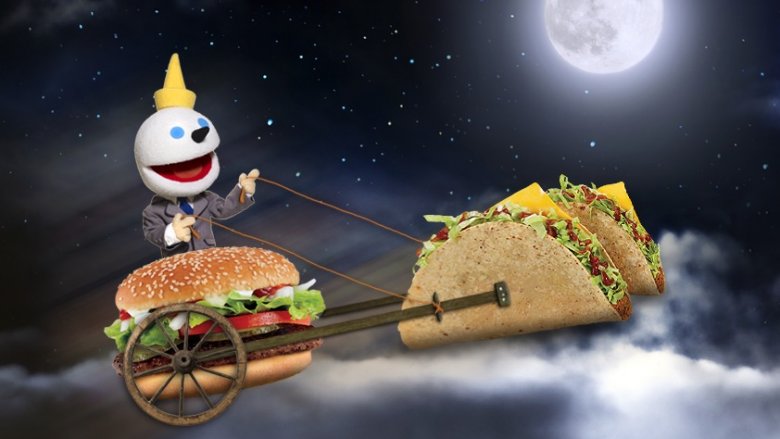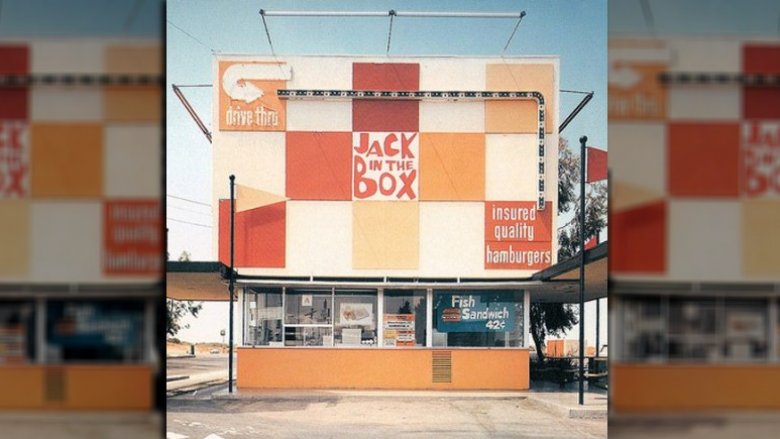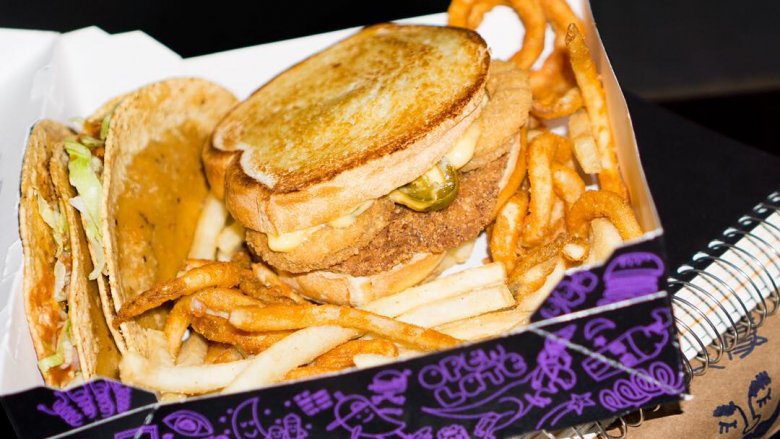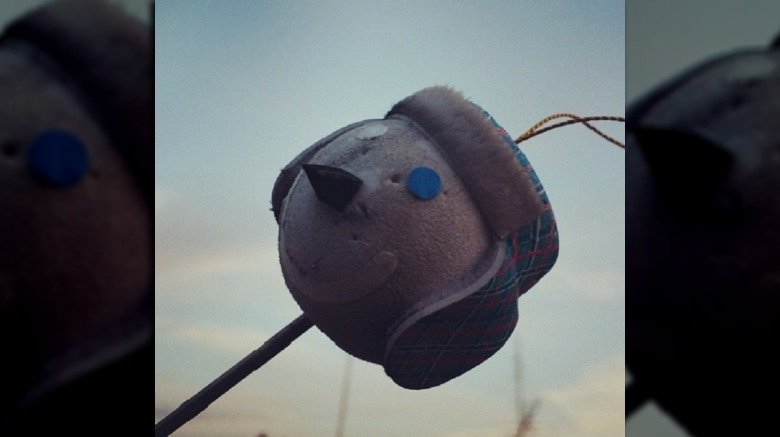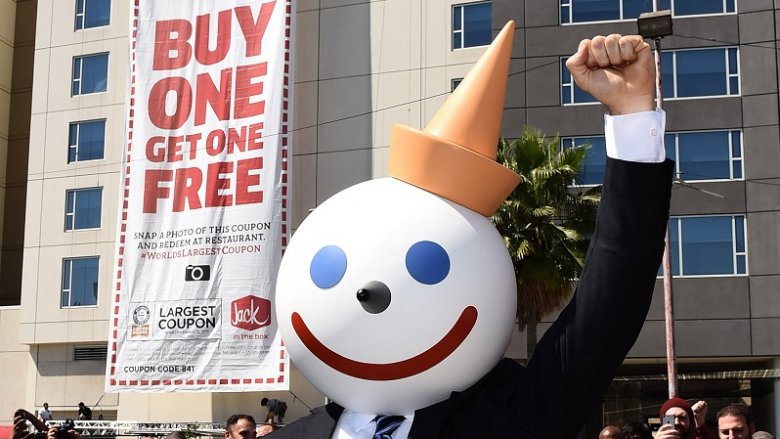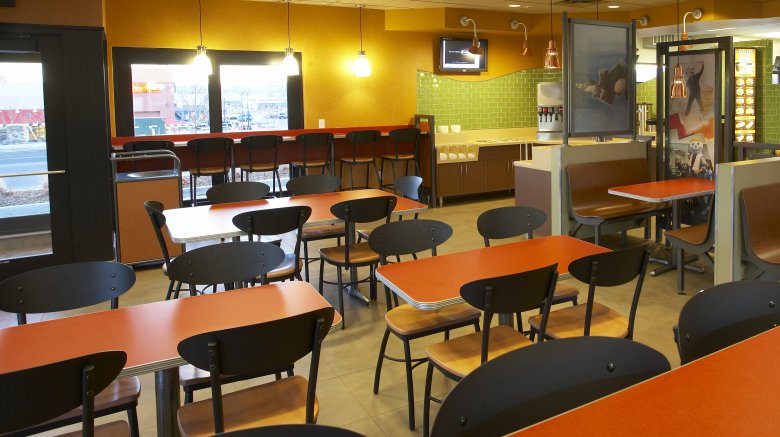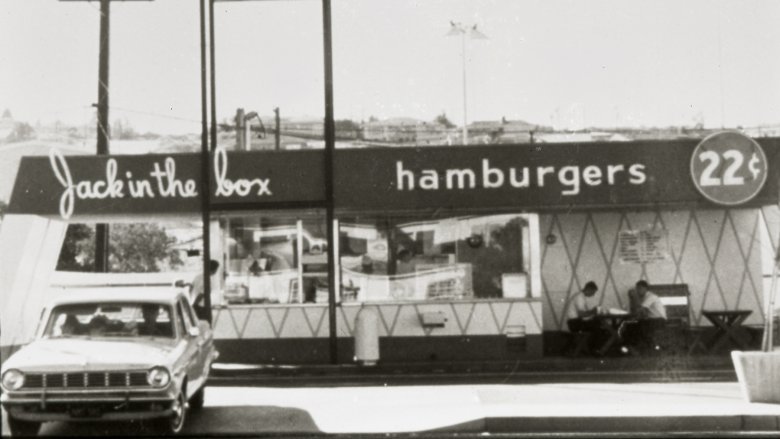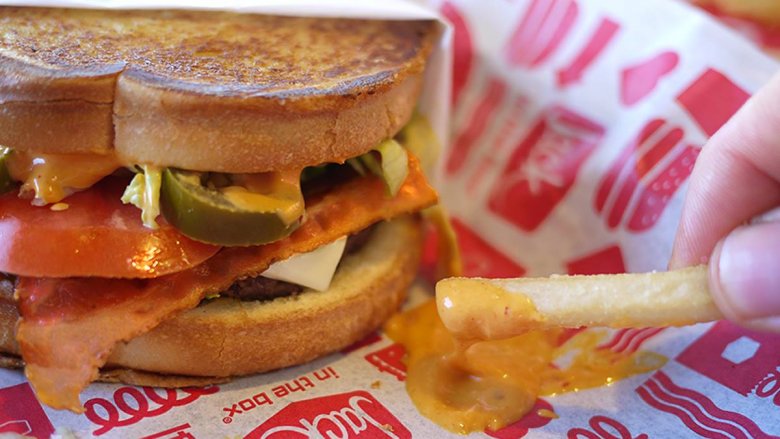The Untold Truth Of Jack In The Box
If you don't like clowns, you're probably not a fan of jack-in-the-box toys. Fortunately, at the Jack in the Box fast food restaurant chain, there aren't any jack-in-the-box toys on the roof ... well, at least not anymore.
Because Jack in the Box is mainly a West Coast and southwestern United States chain, it's possible you've never eaten at one. If not, you're probably at least familiar with the restaurant, thanks to its funny (and sometimes controversial) television commercials.
The Jack in the Box restaurants serve food at all times of the day, including all-day breakfast. It has burgers, sandwiches, salads, desserts, and even some of the strangest tacos you've probably ever seen. There's spicy food, regular hamburger fare, and everything in between.
The history of Jack in the Box is almost as crazy as its menu and its mascot. These are the most interesting aspects of this beloved fast food chain.
The weirdly popular tacos go way back
Often times, burger restaurants are known for something in addition to their signature burgers. Wendy's has the Frosty, for example, while McDonald's has its famous fries. At Jack in the Box, the tacos certainly gain a lot of attention — love them or hate them — and they've been on the menu since the 1950s. They weren't part of the original 1951 Jack in the Box menu, but they were added within the first few years.
Although they've been called "disgusting and perfect" and "a wet envelope of cat food," Jack in the Box sells 554 million tacos each year. The restaurant fries the tortilla with beef inside and then adds hot sauce, lettuce, and a slice of American cheese. (Yes, we said a slice.) Jack in the Box has patented every aspect of its strange taco.
Perhaps part of the appeal is the price. After all, you'll only pay 99 cents for two of them. Even Selena Gomez likes Jack in the Box tacos. We freely admit we don't necessarily get the obsession ... but we wouldn't turn down a couple of them right now.
The mascot has a whole made-up life
Many fast food restaurant chains have mascots, but it's hard to imagine any of those mascots have as much information available about their lives as Jack Box has.
The man behind the reboot of the Jack Box character in 1994 is Dick Sittig. His ad company worked with the restaurant to give the mascot life, both on and off TV, until 2018, when Jack in the Box made a switch to a new agency.
According to Jack in the Box, Jack's bio says he is nearly seven feet tall, and possesses a gene that results in an oversized head. He speaks both English and Spanish, has ran for president twice, has a wife and a son, and has been on some pretty incredible adventures. He also serves as the company's fictional founder and CEO.
At this point, we're wondering how jealous of Jack Box we should be. After all, he has more than 1 million Facebook likes. It almost seems like Jack has had much more fun in his fake life than we've had in our real life ... and, on further consideration, we'd rather not think about it.
Jack Box died in 1980
Jack in the Box has used a clown mascot from the beginning. The roof of the first restaurant had an oversized jack-in-the-box toy on the roof, with the clown watching over the customers. Mid-1950s print ads also featured the clown character prominently. The company made a big change to their advertising strategy in 1980, though.
In an effort to focus on more adult food, it was decided that the clown had to go. Using a new tagline, "The food is better at the Box," the company ran a TV commercial where store employees blew up the Jack mascot. A sweet elderly lady asks them not to blow up the clown because, "He's so cute!" After she tries the new food though, she tells the employees to, "Waste him!" They listened.
So, beyond seeking a change, why did the chain decide to kill off Jack Box? Maybe it's because Time called Jack Box one of the creepiest product mascots of all time.
Jack's ad campaigns have been... weird
In 1994, looking to once again reboot the company's image, Jack in the Box decided to bring the clown mascot back ... and he wasn't happy about being eliminated a decade and a half earlier.
In a TV ad, he walks into the restaurant's headquarters building, saying he's ready to reclaim his rightful spot as head of the company. He then blows up the company boardroom — a violent act that was not well-received by much of the country.
Since Jack's return, the company has continued to deliver fun, strange, and ,super controversial ads.
In a 2009 Super Bowl ad, Jack Box is hit by a bus, and viewers were left not knowing if he would survive (but he miraculously recovers later). He also beat up someone who spoke badly of the chain, fought with Martha Stewart over a sandwich, and got in big trouble for comparing teriyaki bowls to male genitalia.
"Intimidating is part of Jack's persona — a Trump-ian, or actually a Branson kind of thing. He's a larger-than-life celebrity CEO," his creator, Dick Sittig, told AdWeek.
It wasn't always called Jack in the Box
Jack in the Box wasn't Peterson's first restaurant. He actually opened Topsy's Drive-In first, in 1941 in San Diego.
Once he had several Topsy's restaurants going, he changed the name to Oscar's (his middle name). The decor at Oscar's took on a circus theme with a starry-eyed clown, which eventually led to Peterson's renaming of the first Jack in the Box in 1951 with the massive jack-in-the-box toy on the roof.
Despite its early success, the name Jack in the Box still wasn't safe from tinkering, though. Jack in the Box sales declined in the late 1970s, but started to rebound in the early 1980s. Ralston Purina took its good fortune one step too far, though, choosing to rename the entire chain Monterey Jack's.
Less than a year later, they realized their mistake and changed all of the branches back to Jack in the Box. In typical Jack in the Box fashion, the company then released a TV commercial, making fun of itself and its ill-fated decision.
Major tragedy struck in 1993
Had things turned out a little differently, the Jack in the Box story may have ended in 1993, after a tragic E. coli outbreak traced to contaminated burgers at 73 of the restaurant's locations left four people dead — including two children — and nearly sunk the franchise. Several hundred people became across multiple states.
"In the last 10 years, we've sold 400 million pounds of hamburger safely and without incident," Jack in the Box President Robert Nugent said at the time. "Then bang, it hits you. It's your worst, worst nightmare."
The United States Agricultural Department, as well as local health officials, said the problem could've been avoided by cooking the hamburgers to an internal temperature of 155 degrees Fahrenheit. At the time, federal standards called for 140 degrees, but Washington State's standards had been changed to 155 degrees.
"It was the most tragic event in the company's history," Jack in the Box spokesperson Brian Luscom told San Diego Magazine. "Young children died, and the safety of Jack in the Box was questioned."
The restaurant responded by enacting a food safety program called HACCP (Hazard Analysis and Critical Control Points). The USDA calls HACCP the gold standard for safety in the fast food industry.
It has never quite penetrated the East Coast market
Jack in the Box is primarily a west of the Mississippi River franchise, with more than 2,200 restaurants in 21 different states, as well as Guam. The company has made a few different attempts to expand into the eastern United States, but have yet to succeed.
After it reached 1,000 restaurants in the late 1970s, including some in the eastern and Midwest United States, Jack in the Box's struggles with sales caused the chain to close about 200 restaurants in the east and Midwest. That left the chain focused on the southwestern and western United States, which remains its current footprint.
Jack in the Box created plans for another expansion of the chain in the early 1990s, but the E. coli outbreak put those plans on hold, leaving the eastern United States out of the picture again.
Foodmaker divested all of its other businesses and became Jack in the Box Inc. in 1999. The company then made a push into the southeastern United States in the early 2000s, and these Jack in the Box restaurants featured a more contemporary design than previous restaurant versions. However, the chain halted its push in the southeast in the mid-2000s, choosing to focus more on its traditional areas.
It was the first to use a two-way intercom at its drive-through
From the beginning, Jack in the Box was designed as a drive-through restaurant only, taking advantage of the large number of cars on the roads in California after World War II.
But to simplify the process of ordering and to speed up the food preparation process, Peterson installed a two-way speaker system, allowing the patron and the restaurant employee to talk to each other. (Not surprisingly, Jack in the Box used a clown face to decorate its intercom for customers, making the ordering process fun.)
These two-way intercoms are common in fast food drive-through lanes today, but Jack in the Box's system was the first in the industry to be paired with a drive-through. Before the two-way speaker, drivers had to pull up to the pick-up window to order, which slowed down the process.
Currently, Jack in the Box estimates 85 percent of its 500 million annual customers don't eat inside the restaurant, with most opting to use the drive-through system. Jack in the Box loves its drive-through concept so much that it receives some credit for creating National Drive-Thru Day, celebrated every July 24. (Now you know when to give your favorite drive-through employee a card.)
Its Munchie Meals are aimed at exactly who you think
Some of Jack in the Box's highest calorie items are aimed squarely at folks who have the munchies ... for whatever reason.
Jack's Munchie Meals give patrons a huge meal that should keep hunger pangs at bay. The Munchie Meals — which feature a sandwich, tacos, fries (a mix of regular and seasoned), and a drink — carry calorie counts between 1,720 and 2,010. (Remember that the FDA recommends between 2,000 and 2,500 calories per day for most people.)
And in case you're wondering, yes, the restaurant is aiming these meals directly at recreational marijuana users and the munchies they inevitably develop. When you consider that West Coast states, where Jack in the Box has a large number of restaurants, have legalized recreational marijuana use, it makes some sense that Jack in the Box would attempt to cater to people who are legally using cannabis.
Jack in the Box antenna toppers are everywhere
If it feels like Jack is watching your every move, there's a reason. Lots of drivers in areas where Jack in the Box is popular have Jack antenna balls on their vehicles, and seeing all of those mini Jack heads can be a little creepy after a while.
The restaurant says it has given guests more than 32 million Jack Box antenna balls since 1995.
These antenna balls originally were awarded as freebies with a burger promotion and only featured a very basic Jack head. However, they have become quite collectible over the years, as the restaurant created special versions for certain occasions or certain promotions.
The Jack Box mascot has appeared on many other promotional and collectible items over the years, including a Pez dispenser in 1999. Other Jack items include 4-inch bendable figurines and bobble heads.
It created the world's largest coupon
One of the restaurant's biggest promotions definitely grabbed attention in 2015, as the restaurant created the world's largest coupon, according to Guinness World Records. The massive coupon was more than 80 feet tall and 25 feet wide. That amounts to about eight stories high, which was proven when the restaurant hung it from a building for the photo ops.
However, producing a coupon of that size was not enough. In order to count as a world record, the large coupon had to be physically redeemed. The Jack mascot and 12 other people carried the coupon through the streets of Los Angeles to a Jack in the Box restaurant. When it wouldn't fit through the door, they went to the drive-through lane to redeem it and claim the world record.
The coupon promoted the new (at the time) Buttery Jack Burger, giving customers a buy-one-get-one-free deal. Customers only needed a screenshot of the giant coupon on their smartphones to receive the deal.
It tried a JBX Grill concept in the mid-2000s that failed
Fast food restaurants aren't really known for having great service, but Jack in the Box once tried to give its customers an upscale restaurant concept. The idea, called JBX Grill, involved using a fast-casual dining concept that featured more freshly prepared food options than what was available at Jack in the Box. JBX Grills did not share a menu with Jack in the Box; it was a completely separate type of restaurant.
The JBX Grill restaurants were tested in 2004 and 2005 in California and Idaho. Patrons ordered at a counter, but then a server brought the food to the table. Servers monitored the dining room to help customers, which is vastly different from a fast food restaurant.
However, the JBX Grill test restaurants didn't last long, and the company announced late in 2005 that it was scrapping the idea.
The founder had an interesting life
Robert O. Peterson is well known for founding Jack in the Box in 1951. He had 300 restaurants by 1967 when he sold the chain to Ralston-Purina. But his life away from the fast food restaurant was even more interesting.
Peterson associated with famous people throughout his life. He and fellow San Diego State College students Ark Linkletter, Faye Emerson, and Gregory Peck ran Friday dances, raising money for college expenses. He even married the first female mayor in San Diego history, Maureen O'Connor. (After his death, she was charged with stealing $2.1 million from Peterson's charity to fund a gambling addiction.)
During his life, he was credited with helping transform San Diego from a Naval base town into a major city with his philanthropic and civic minded work. He received a Medal of Honor from Paris for his support of the arts. And UC San Diego named a lecture hall in his honor after his contributions.
But perhaps the strangest aspect of his life was that he ended up on President Nixon's "enemies list." Peterson, a registered republican, was never shy about supporting democratic political candidates when he felt they warranted it, which caused him to end up on the famous list.
The menu options don't skimp on calories
If you're going to a Jack in the Box for a meal, you probably aren't all that worried about calorie consumption. After all, fast food is notoriously high in calories.
However, if you are counting calories, you may want to stay away from these Jack in the Box menu items that carry 900-plus calories ... or at least counter-balance them by choosing a Jack in the Box salad the next time you visit.
- Large shakes with whipped toppings: 1,090-1,150 calories
- Grande sausage breakfast burrito: 1,040 calories
- 20-piece chicken nuggets: 950 calories
- Bacon ultimate cheeseburger: 930 calories
The chain even offers something called H'angry Chicken Hash. Don't let the chicken fool you into thinking this is a healthier choice, as 580 of its 850 calories come from fat. (It's the "tasty white cheese sauce" on the chicken that gets you.)
At least Jack in the Box no longer offers its Bacon Sirloin Cheeseburger, which had a whopping 1,030 calories.
